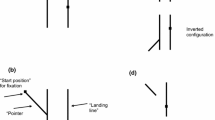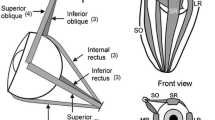Summary
The spatial and temporal organixation of unrestricted limb movements directed to small visual targets was examined in two separate experiments. Videotape records of the subjects' performance allowed us to analyze the trajectory of the limb movement through 3-dimensional space. Horizontal eye movements during reaching were measured by infrared corneal reflection. In both experiments, the trajectories of the different reaches approximated straight line paths and the velocity profile revealed an initial rapid acceleration followed by a prolonged period of deceleration. In Experiment 1, in which the target light was presented to the right or left of a central fixation point at either 10° or 20° eccentricity, the most consistent differences were observed between reaches directed across the body axis to targets presented in the contralateral visual field and reaches directed at ipsilateral targets. Ipsilateral reaches were initiated more quickly, were completed more rapidly, and were more accurate than contralateral reaches. While these findings suggest that hemispherically organized neural systems are involved in the programming of visually guided limb movements, it was not clear whether the inefficiency of the contralateral movements was due to reaching across the body axis or reaching into the visual hemifield contralateral to the hand being used. Therefore, in Experiment 2, the position of the fixation point was varied such that the effects of visual field and body axis could be disembedded. In this experiment, the kinematics of the reaching movement were shown to be independent of the point of visual fixation and varied only as a function of the laterality of the target position relative to the body axis. This finding suggests that the kinematics of a reaching movement are determined by differences in the processing of neural systems associated with motor output, after the target has been localized in space. The effect of target laterality on response latency and accuracy, however, could not be attributed to a single frame of reference, or to a simple additive effect of both. These findings illustrate the complex integration of visual spatial information which must take place in order to reach accurately to goal objects in extrapersonal space. Comparison of ocular and manual performance revealed a close relationship between movement latency for both motor systems. Thus, rightward-going eye movements to a given target were initiated more quickly when accompanied by reaches with the right hand than when they were accompanied by reaches with the left hand. The finding that the latency of eye movements in one direction was influenced by which hand was being used to reach suggests that reaching toward a target under visual control involves a common integration of both eye and hand movements.
Similar content being viewed by others
References
Abend W, Bizzi E, Morasso P (1982) Human arm trajectory formation. Brain 105: 331–348
Anzola G, Bertoloni G, Buchtel H, Rizzolatti G (1977) Spatial compatibility and anatomical factors in simple and choice reaction time. Neuropsychologia 15: 295–302
Bashore TR (1981) Vocal and manual reaction time estimates of interhemispheric transmission time. Psychol Bull 89: 352–368
Beaubaton D, Hay L (1982) Integration of visual cues in rapid goal-directed movements. Behav Brain Res 5: 92–93
Biguer B, Jeannerod M, Prablanc P (1982) The coordination of eye, head and arm movements during reaching at a single visual target. Exp Brain Res 46: 301–304
Bizzi E, Acconero N, Chapple W, Hogan N (1982) Arm trajectory formation in monkeys. Exp Brain Res 46: 139–143
Bowers D, Heilman K (1980) Pseudoneglect: effects of hemispace on a tactile line bisection task. Neuropsychologia 18: 491–498
Bowers D, Heilman K, Van Den Abell T (1981) Hemispace-VHP compatibility. Neuropsychologia 19: 757–765
Brinkman J, Kuypers HGJM (1973) Cerebral control of contralateral and ipsilateral arm, hand and finger movements in the split-brain rhesus monkey. Brain 96: 653–674
Carlton LG (1981) Processing visual feedback information for movement control. J Exp Psychol (Hum Percept) 7: 1019–1030
Carpenter RHS (1977) Movements of the eyes. Pion, London
Cooke JD (1980) The organization of simple skilled movements. In: Stelmach GE, Requin J (eds) Tutorials in motor behaviour. North-Holland Publishing, New York
Fisk JD, Goodale MA (1983) Eye and limb movements in visually guided reaching. Invest Ophthalmol Vis Sci 24 (Suppl): 82
Fisk JD, Goodale MA (1984) Differences in the organization of visually guided reaching to ipsilateral and contralateral targets. Behav Brain Res 12: 189–190
Flament D, Hore J, Vilis T (1984) Braking of fast and accurate elbow flexions in the monkey. J Physiol (Lond) 349: 195–203
Freund HJ, Budingen HJ (1978) The relationship between speed and amplitude of the fastest voluntary contractions of human arm muscles. Exp Brain Res 31: 1–12
Georgopoulos AP, Kalaska JF, Massey JT (1981) Spatial trajectories and reaction times of aimed movements: effects of practice, uncertainty, and change in target location. J Neurophysiol 46: 725–743
Goodale MA, Fisk JD (1984) Laterality differences in eye-hand organization during visually guided reaching. Behav Brain Res 12: 194–195
Hallet M, Marsden CD (1979) Ballistic flexion movements of the human thumb. J Physiol (Lond) 294: 33–50
Hay L (1979) Spatial-temporal analysis in children: motor programs versus feedback in the development of reaching. J. Motor Behav 11: 189–200
Heilman KM (1979) Neglect and related disorders. In: Heilman KM, Valenstein E (eds) Clinical neuropsychology. Oxford University Press, New York
Jeannerod M (1984) The timing of natural prehension movements. J Mot Behav 16: 235–254
Keele SW, Posner MI (1968) Processing of visual feedback in rapid movements. J Exp Psychol 77: 155–158
Kimura D (1982) Left-hemisphere control of oral and brachial movements and their relation to communication. Philos Trans R Soc Lond (Biol) 298: 135–149
Lacquaniti F, Soechting JF (1982) Coordination of arm and wrist motion during a reaching task. J Neurosci 2: 399–408
Lawrence DG, Kuypers HGJM (1968a) The functional organization of the motor system in the monkey. I: the effects of bilateral pyramidal lesions. Brain 91: 1–14
Lawrence DG, Kuypers HGJM (1968b) The functional organization of the motor system in the monkey. II: the effects of lesions of the descending brainstem pathways. Brain 91:15–36
Lestienne F (1979) Effects of inertial load and velocity on the braking process of voluntary limb movements. Exp Brain Res 35: 407–418
Morasso P (1981) Spatial control of arm movements. Exp Brain Res 42: 223–227
Ostry DJ, Keller E, Parush A (1983) Similarities in the control of the speech articulators and limbs: kinematics of tongue dorsum movement in speech. J Exp Psychol (Hum Percept) 9: 622–636
Paillard J (1982) The contribution of peripheral and central vision to visually guided reaching. In: Ingle D, Goodale MA, Mansfield RJW (eds) Analysis of visual behaviour. MIT Press, Cambridge MA
Paillard J, Beaubaton D (1975) Problemes poses par le controle visuel de la motricite proximale et distale apres disconnexion hemispherique chez le singe. In: Schott B, Michel F (eds) Les syndromes de disconnection calleuse chez l'homme. Presses de l'Universite de Lyon, Lyon
Pfoffenberger AT (1912) Reaction time to retinal stimulation with special reference to the time lost in conduction through nervous centers. Arch Psychol 23: 1–73
Prablanc C, Eschallier JF, Komilis E, Jeannerod M (1979) Optimal response of eye and hand motor systems in pointing at a visual target. Biol Cybern 35: 113–124
Soechting JF (1984) Effect of target size on spatial and temporal characteristics of a pointing movement in man. Exp Brain Res 54: 121–132
Woodworth RS (1899) The accuracy of voluntary movements. Psychol Mono 3: Whole No. 13
Author information
Authors and Affiliations
Additional information
This study was supported by grant no. MA-7269 from the Medical Research Council of Canada to M. A. Goodale
Rights and permissions
About this article
Cite this article
Fisk, J.D., Goodale, M.A. The organization of eye and limb movements during unrestricted reaching to targets in contralateral and ipsilateral visual space. Exp Brain Res 60, 159–178 (1985). https://doi.org/10.1007/BF00237028
Received:
Accepted:
Issue Date:
DOI: https://doi.org/10.1007/BF00237028




